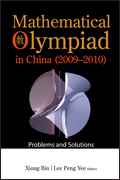Review of Mathematical Olympiad in China (2009-2010)
|

|
In the combined seventeen pages of Preface and Introduction the authors outline the history of mathematical olympiads around the world and, in particular, in China. Two paragraphs concerning the situation in China are especially revealing:
In the era of Cultural Revolution, the whole educational system in China was in chaos. The mathematical competition came to a complete halt. In contrast, the mathematical competition in the former Soviet Union was still on-going during the war and a time under difficult political situation.
In 1985 China took part in an IMO for the first time. The two Chinese contestants shared between them one bronze medal - a less than encouraging performance for the most populous country in the world.
From 1986 onward, other than the year when IMO was organized in Taiwan, China had been sending a 6-member team to IMO. Up to 2011, China had been awarded the overall team champion for 17 times.
The book throws light on the effort involved and organization of that transition. The process whose ultimate end is the selection of the Chinese IMO team is multistage, with several regional olympiads and a special olympiad for girls to boost their participation. The book is a collection of problems from all those competitions run in 2009-2010, expanded to include the problems from IMO for the two years. The problems (which are never trivial) naturally progress in difficulty and, in the book, are immediately followed by solutions, often more than one.
Although the authors do not mention that, the book is probably intended to math olympiad participants and their coaches. No doubt, these two categories of readers will enjoy the problems and learn from the solutions. However, on browsing the book it occurred to me that the book may have a broader audience. I would suggest that many of the problems in the book can be dissected into simpler ones that could be used as non-routine (and to many entertaining) exercises in regular algebra, or even arithmetic classes. For example (pp 17-18),
Let f(x)=x/sqrt(1 + x^2). Form iterations f2 = f(f(x)), f3 = f(f(f(x))), and so on. Find f99(1).
Calculating f(f(x)) = x/sqrt(1 + 2x^2) and then also f(f(f(x)))=x/sqrt(1 + 3x^2) as an exercise in algebraic manipulation independent of the olympiad problem may actually lead to an insight as to how the next iterate may look like, affording a simple math discovery.
As another example (pp 94-96),
Can one divide the set {1, 2, ..., 96} into 32 subsets of three elements each, such that the sums of the three elements in the subsets are all equal?
Can one divide the set {1, 2, ..., 99} into 33 subsets of three elements each, such that the sums of the three elements in the subsets are all equal?
Why not to try numbers smaller than 96 or 99, say 9 and 12? With small numbers, the problems become accessible even in elementary school. The simpler of the two (12) becomes more difficult, for it requires reasoning, while the one that has a less than trivial solution (9) may be solved by simply interchanging cards or just pieces of paper with integers 1-9 written on them. This could be a stepping stone to the phenomenon of magic squares.
While similar remarks might apply to other problem collections, many problems in this one seem to be particularly suitable to such a reduction to a more elementary level. Moreover, the book's organization where solutions immediately follow problems, should prove a convenience for inspiring math teachers with limited olympiad experience.
The book is referred to at
- Self-documenting Iterations
- On the Intersection of kx and |sin(x)|
- Triangles with Sides in Geometric Progression
- Problem 1 from the IMO 2009
- Sums of the Elements of Three Element Subsets
Mathematical Olympiad in China (2009-2010). Problems and Solutions, World Scientific Publishing Company (February 20, 2013). Softcover, 204 pp, $38, but could be had for $28.06 at amazon.com. ISBN 9814390216.
|Up| |Contact| |Front page| |Contents|
Copyright © 1996-2018 Alexander Bogomolny73496899
